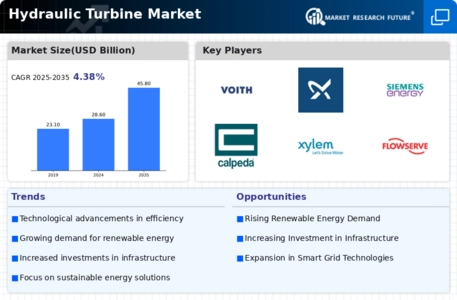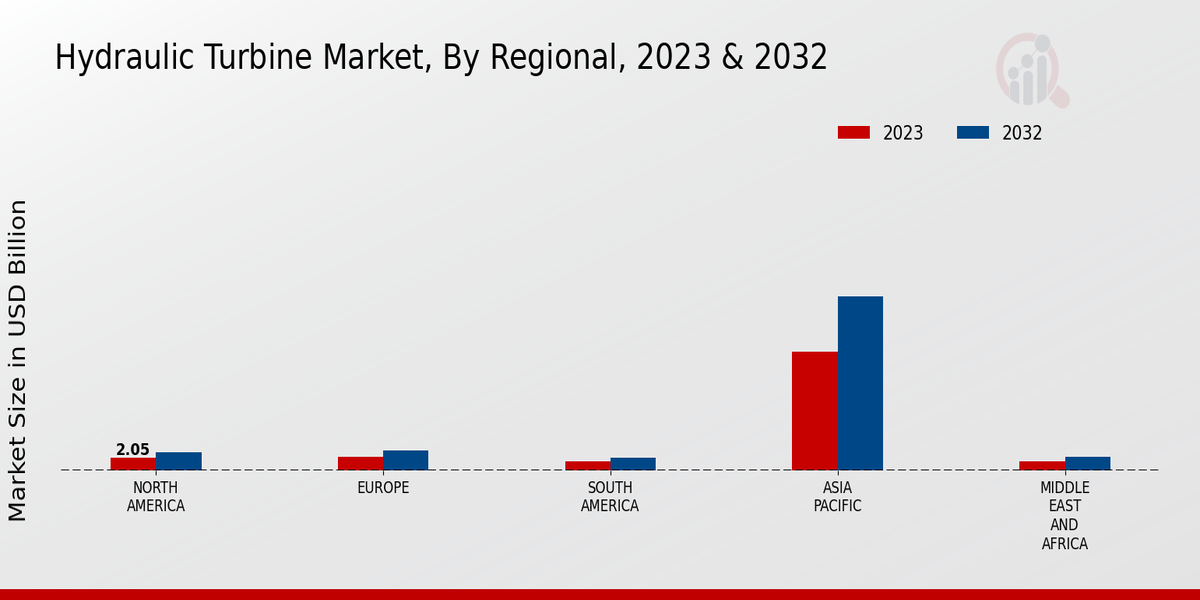Increasing Energy Demand
The rising global energy demand is a primary driver for the Global Hydraulic Turbine Market Industry. As populations grow and economies develop, the need for reliable and sustainable energy sources intensifies. Hydropower, being one of the most established renewable energy sources, is well-positioned to meet this demand. Regions such as Southeast Asia and Africa are experiencing rapid urbanization, leading to increased electricity consumption. This surge in energy requirements is likely to propel investments in hydropower infrastructure, thereby enhancing the market's growth trajectory in the coming years.
Market Growth Projections
The Global Hydraulic Turbine Market Industry is projected to experience substantial growth over the next decade. With a market value expected to reach 28.6 USD Billion in 2024 and 45.8 USD Billion by 2035, the industry is poised for a compound annual growth rate of 4.38% from 2025 to 2035. This growth trajectory reflects the increasing investments in hydropower infrastructure and the rising demand for renewable energy sources globally. The market's expansion is likely to be driven by technological advancements, government incentives, and the urgent need for sustainable energy solutions.
Government Incentives and Funding
Government incentives play a crucial role in the expansion of the Global Hydraulic Turbine Market Industry. Many nations are offering financial support and subsidies for hydropower projects, which can significantly lower the initial investment barrier. For instance, the U.S. Department of Energy has initiated programs to promote hydropower development, which encourages private sector participation. Such funding mechanisms are likely to stimulate market growth, as they make it easier for developers to initiate projects. This trend is expected to contribute to the market's projected growth to 28.6 USD Billion in 2024.
Growing Demand for Renewable Energy
The increasing global emphasis on renewable energy sources propels the Global Hydraulic Turbine Market Industry forward. Governments worldwide are implementing policies to reduce carbon emissions, thereby enhancing the attractiveness of hydropower as a clean energy source. For instance, countries like China and Brazil are investing heavily in hydropower projects, which are expected to contribute significantly to the market's growth. The market is projected to reach 28.6 USD Billion in 2024, with a compound annual growth rate of 4.38% anticipated from 2025 to 2035, ultimately reaching 45.8 USD Billion by 2035.
Environmental Sustainability Initiatives
The Global Hydraulic Turbine Market Industry is significantly influenced by the increasing focus on environmental sustainability. As climate change concerns escalate, there is a growing recognition of hydropower's role in providing a sustainable energy solution. Initiatives aimed at reducing greenhouse gas emissions are prompting countries to invest in hydropower projects. For example, the European Union has set ambitious targets for renewable energy adoption, which includes hydropower. This commitment to sustainability is likely to foster a favorable environment for the hydraulic turbine market, contributing to its anticipated growth.
Technological Advancements in Turbine Design
Innovations in turbine technology are transforming the Global Hydraulic Turbine Market Industry. Enhanced designs, such as variable speed turbines and improved materials, are increasing efficiency and reducing operational costs. For example, the development of advanced computational fluid dynamics tools allows for better optimization of turbine performance. These advancements not only improve energy output but also extend the lifespan of turbines, making them more appealing to investors. As efficiency improves, the market is likely to see a surge in new installations, further driving growth in the coming years.










